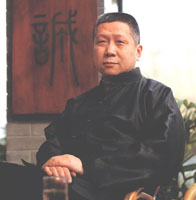 |
|
Ma Weidu, the owner of China's first private museum, finds time to relax surrounded by his many antiques
|
The rows of flat shabby houses in the east Beijing suburb of Zhangwanfen are broken by a building that looks decidedly out of place. It's new, draws heavily on Chinese architecture and has turned the sleepy hollow into a tourist attraction.
The building is China's first private antique museum, the Guanfu Museum, and the hordes of people beating a path to its door come not only for the antiques. There is another attraction, the museum's owner- Ma Weidu.
A well-known antique collector, Ma gained national attention after he gave a series of lectures on antique collecting on the TV program Lecture Room on China Central Television.
Fascinated by all things old
"I was born to be a collector," said Ma, 53. "I prefer old things to new things and I am also interested in the unknown. It is really a pleasure for me to discover the stories hiding behind every antique."
Ma started his antique collection in the 1980s, when he was a literature editor at China Youth Press. He is also a widely published writer, having written several famous novels and TV series scripts with other writers. "The experience of being a literature editor and writer helps me to have a better understanding of the cultural meaning of antiques," he said.
Becoming increasingly interested in antiques, Ma finally quit his job as an editor and dedicated himself to his collection. "When you see a bowl more than 500 years old, and you can tell when it was made, who the owner was, and where it was buried, you simply get excited," he said.
His collections at first focused mainly on china, pottery and furniture of Ming (1368-1644) and Qing (1644-1911) dynasties. In the 1990s, the number of his collection surpassed 1,000. "From these antiques, we can see the living conditions and attitude of ancient people," Ma said. Using an ancient bed as an example, he explained how in the past people slept in beds with curtains surrounding the four sides of the bed. It created an atmosphere of safety, said Ma.
In 1997, Ma established China's first private museum-Guanfu Museum in Beijing. The word guanfu comes from a sentence in the classic Dao De Jing (Classic of the Way and Virtue) written by ancient philosopher Laozi, and means looking back.
Ma said that in 1992 he held an exhibition and realized that many people were eager to know more about antiques. He decided to set up a museum to give people more opportunities to enjoy the many artifacts.
In the early 1990s, the idea of private museums was new, and people thought he had bitten off more than he could chew.
"I seldom consider the difficulties before I do something," said Ma. However, this time the difficulties did indeed turn out to be many. It took him more than four years to get approval from the government for establishing the museum. In 1997, he finally set up his operation, but had to move several times before eventually settling down in Zhangwanfen in 2004.
"Our museum grows very fast. Now it occupies about 4,000 square meters. In downtown Beijing the rent would be much higher for a place as big as this, and that is one of the reasons we have settled in Zhangwanfen," said Ma.
When it comes to putting a value on the museum's collection, Ma said it is not easy since the prices are not fixed as is the case with most goods on other markets. He gave an example of a bottle made in the Song Dynasty (960-1279). A Japanese collector sold a similar bottle, which was not in as good condition as Ma's for more than 10 million yuan ($1.46 million) on the international market.
Another antique that impresses visitors is a pair of Buddhist towers made of red sandalwood. The 2.16-meter-high towers are birthday gifts from an emperor in the Qing Dynasty to his mother. This pair of towers were taken to England more than 100 years ago. In 2003, the towers appeared at Sotheby's Hong Kong auction, where Ma paid 3.628 million yuan ($530,800) for them. "A lot of bidders didn't know at first that it was made of red sandalwood, so I finally could get it at a very low price, " he said. The towers are today the most valuable pieces in the museum.
Guanfu Museum also opened branches in two other cities. One in Hangzhou, the capital city of east China's Zhejiang Province, was opened in 2001, and another one in Xiamen, a city in south China's Fujian Province, in 2005.